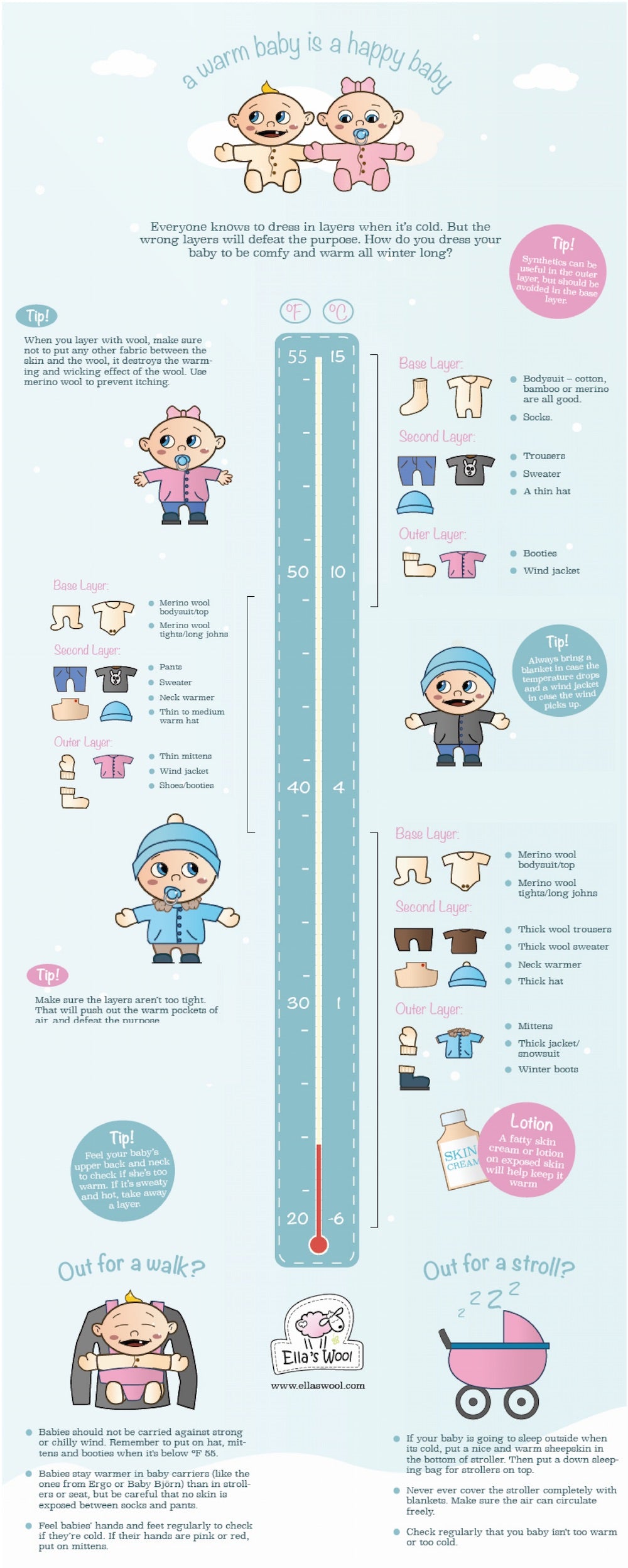How should you dress your kids when it gets cold outside?
Everyone knows to dress in layers when it’s cold. But the wrong layers will defeat the purpose. How do you dress your baby to be comfy and warm all winter long?
Our infographic gives recommendations for what kids should wear in temperatures ranging from 20 to 55 °F (-6 to 15 °C).

A warm baby is a happy baby
How to dress your baby when it's ~ 38 – 47 °F (4 – 8 °C)
Base Layer:
Second Layer:
- Pants
- Sweater
- Neck warmer
- Thin to medium warm hat
Outer Layer:
- Thin mittens
- Wind jacket
- Shoes/booties
How to dress your baby when it's ~ 20 – 37 °F (-6 – 3 °C)
Base Layer:
Second Layer:
- Thick wool trousers
- Thick wool sweater
- Neck warmer
- Thick hat
Outer Layer:
- Mittens mittens
- Thick jacket or snowsuit
- Winter boots
For babies sleeping in the stroller
If your baby is going to sleep outside when its cold, put a nice and warm sheepskin in the bottom of the stroller. If you don't have one, use a blanket – preferably wool.
This will keep the cold from seeping in from below. Then, put a down sleeping bag for strollers on top.
Some parents like to put a blanket over the stroller to keep some of the warm air inside. If you do that, make sure you never, ever cover the opening completely. Leave a gap large enough that air can circulate freely.
Check regularly that you baby isn't too warm or too cold.
You can feel your baby's neck and upper back to check if they are too warm. It should not be clammy. To check if they are cold, feel their fingers and/or toes, and their tummy, if you are in doubt.
Some notes on the base layer
When you layer with wool, make sure not to put any other fabric between the skin and the wool, it destroys the warming and wicking effect of the wool. Use merino wool to prevent itching.
Make sure the layers aren’t too tight. That will push out the warm pockets of air, and defeat the purpose.
Synthetics can be useful in the outer layer, but should generally be avoided in kids' base layers. While there are different kinds of synthetic base layers, they are usually best suited for active adults, not kids playing.
The difference is that active adults tend to sweat more, and they often need the moisture wicking qualities more than the warmth. (Though even adults will usually prefer merino or a wool blend to 100% synthetics.)
Kids, on the other hand, will often switch between running around and sitting still, and they don't think twice about sitting down in the snow. Wool is amazing for staying warm and comfortable under all kinds of different conditions.
Going for a walk?
Babies should not be carried facing a strong or chilly wind. Remember to put on hat, mittens, and booties when it's below 55 °F.
Babies stay warmer in baby carriers (like the ones from Ergo or Baby Björn) than in strollers or seats, but be careful that no skin is exposed between the socks and pants.
Feel babies’ hands and feet regularly to check if they’re cold. If their hands are getting pink or red, put on mittens.
Tips and tricks for staying warm
A fatty skin cream or lotion on exposed skin will help keep it warm. But make sure not to use a water-based moisturizer. That might make the cold much worse.
Always bring a blanket in case the temperature drops, and a wind jacket in case the wind picks up.


![How to dress babies for cold weather [Infographic in Celsius and Fahrenheit]](http://ellaswool.com/cdn/shop/articles/Infographic_2018_1024x1024.png?v=1609668542)